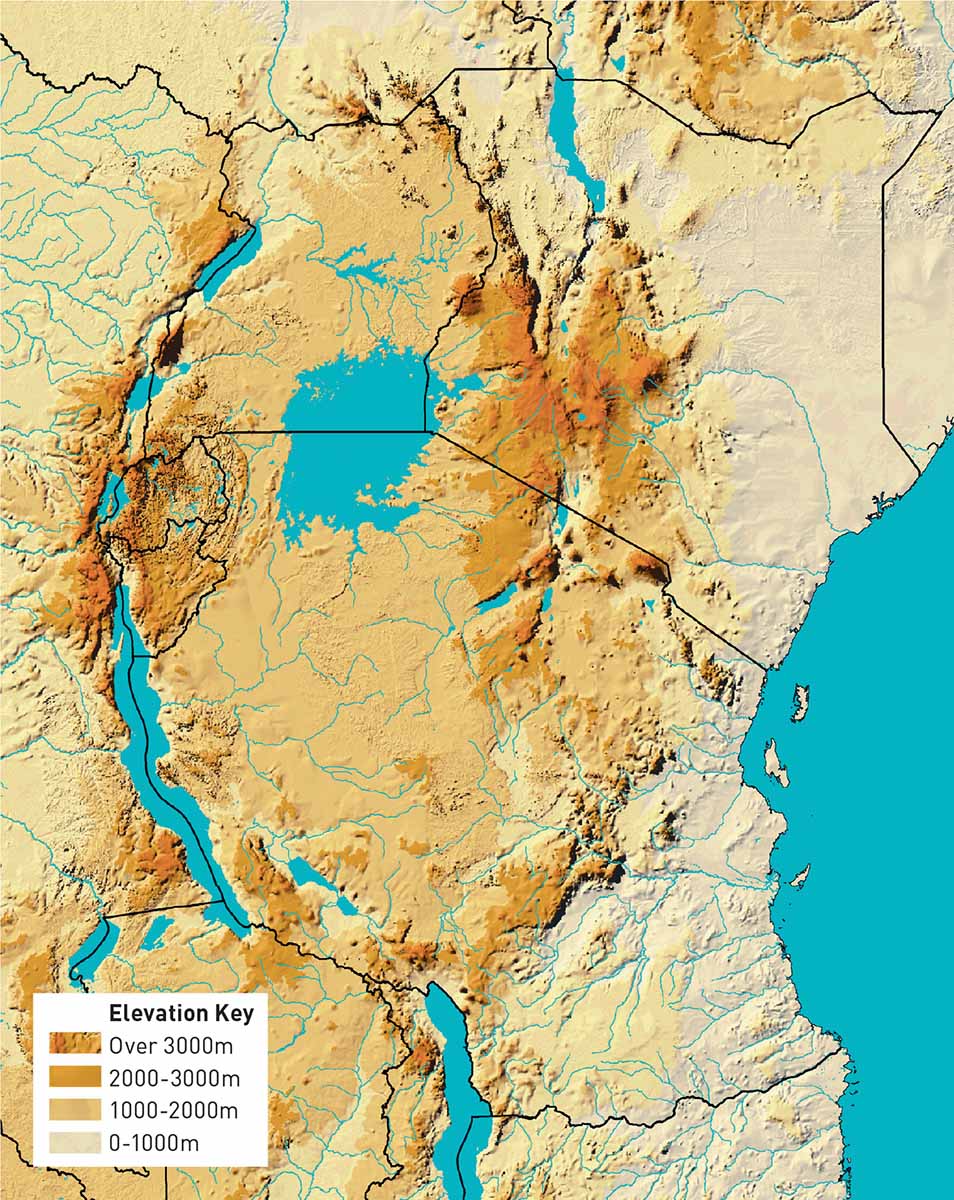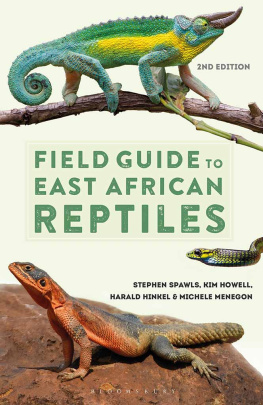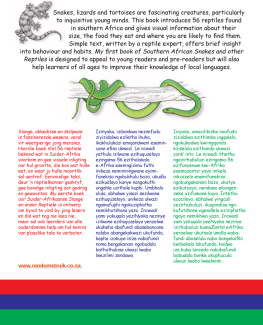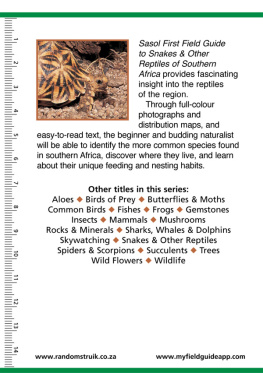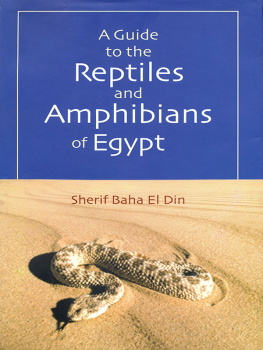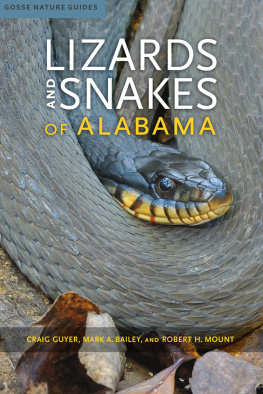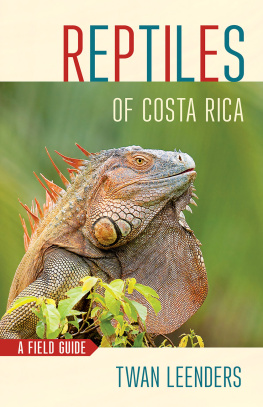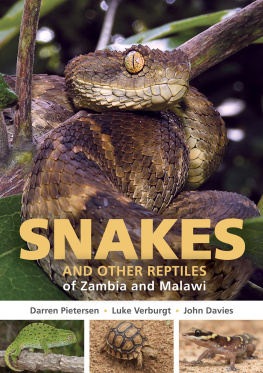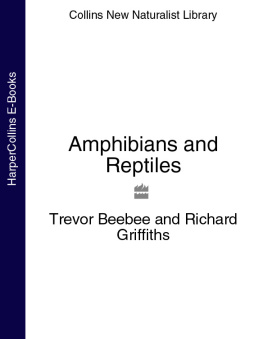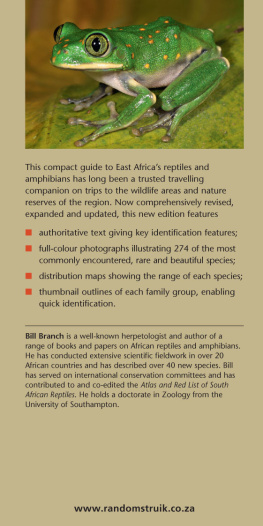
Bloomsbury Wildlife
An imprint of Bloomsbury Publishing Plc
50 Bedford Square | 1385 Broadway |
London | New York |
WC1B 3DP | NY 10018 |
UK | USA |
www.bloomsbury.com
This electronic edition published in 2018 by Bloomsbury Publishing Plc
BLOOMSBURY, BLOOMSBURY WILDLIFE and the Diana logo are trademarks of Bloomsbury Publishing Plc
First published 2018
Text 2018 by Stephen Spawls, Kim Howell, Harald Hinkel and Michele Menegon Photos 2018 by Stephen Spawls, Kim Howell, Harald Hinkel and Michele Menegon, and by photographers as credited in the photo captions
Stephen Spawls, Kim Howell, Harald Hinkel and Michele Menegon have asserted their right under the Copyright, Designs and Patents Act, 1988, to be identified as Authors of this work.
All rights reserved
You may not copy, distribute, transmit, reproduce or otherwise make available this publication (or any part of it) in any form, or by any means (including without limitation electronic, digital, optical, mechanical, photocopying, printing, recording or otherwise), without the prior written permission of the publisher. Any person who does any unauthorised act in relation to this publication may be liable to criminal prosecution and civil claims for damages.
No responsibility for loss caused to any individual or organisation acting on or refraining from action as a result of the material in this publication can be accepted by Bloomsbury or the author.
British Library Cataloguing-in-Publication Data
A catalogue record for this book is available from the British Library.
Library of Congress Cataloguing-in-Publication data has been applied for.
ISBN: 978-1-4729-3561-8 (PB)
ISBN: 978-1-4729-3562-5 (eBook)
ISBN: 978-1-4729-4309-5 (ePDF)
Design by Jocelyn Lucas
To find out more about our authors and their books please visit www.bloomsbury.com where you will find extracts, author interviews and details of forthcoming events, and to be the first to hear about latest releases and special offers, sign up for our newsletters.
Frontispiece: Micrelaps vaillanti Guineafowl Snake. Anthony Childs, Meru National Park
CONTENTS

Pelusios broadleyi Lake Turkana Hinged Terrapin Roberto Sindaco
INTRODUCTORY ESSAYS
SPECIES ACCOUNTS
APPENDICES
The scientist does not study nature because it is useful, he studies it because he delights in it, and he delights in it because it is beautiful. If nature were not beautiful, it would not be worth knowing, and if nature were not worth knowing, life would not be worth living
Henri Poincar, scientist and philosopher, 18541912
Good natural history is a source of timeless, priceless information for the biological sciences
Harry W. Greene, American herpetologist, 1945

Philothamnus punctatus Speckled Green Snake Michele Menegon
INTRODUCTION

Natriciteres sylvatica Forest Marsh Snake Michele Menegon
In 2002 we published a field guide to the reptiles of East Africa. Since that date there have been many changes in the East African herpetological field. New species have been found in East Africa and described. Existing species have been split, animals have been recorded in East Africa for the first time; range extensions for existing species have been recorded. As a result of systematic studies, particularly those based on DNA and other biological molecules, many species have been reclassified, regrouped and their scientific names changed; new relationships have been discovered.
Our original guide described 432 species of reptile from East Africa; the new list contains 492 species. Well over 100 species have had their generic names changed. It is time for an updating, to document that progress, and we hope that this book serves that purpose. In order to produce a portable soft-backed book we have reduced the size of some of the original introductory material, and also abbreviated many species accounts without (we hope) losing too much essential material. Those who have a copy of our original field guide will find that the running order has changed slightly, particularly with the snakes, to reflect the latest evolutionary relationships, although where there is no obvious hierarchy we have tried to retain something of the original order. There is some debate over the order of appearance of the various groups and taxa in the evolutionary record. The general consensus is that, in order of major splits, the turtles and tortoises are the oldest group, then crocodiles, then lizards, including amphisbaenians, and finally snakes. However, in this book we have followed what might be called a traditional running order; with the turtles and tortoises first, then lizards, amphisbaenians, crocodiles, and finally snakes. Within the generic accounts, if species are unequivocally closely related we have grouped them in order, if the situation is not clear cut then they are alphabetical.
As we said in the first edition, this book is not the last word in East African herpetolo gy. There will never be a last word. There is a lot to be discovered. New discoveries, range extensions and taxonomic changes are always occurring. Biological data on the animals themselves is continuously being updated. Huge areas of East Africa have yet to be visited by herpetologists. And the field of African herpetology is desperately short of workers. Throughout this book, you will encounter such expressions as never knowingly seen alive, or never photographed alive, or details unknown. There is much research to be done. Be part of it. The active enthusiast, be they scientist or amateur, can make a big difference. So get into the field. Observe, document, photograph and collect; source what is appropriately called the ground truth. The distribution records of even the most common of our reptiles are patchy. Many of the range extensions in this new edition result from a single observa tion by an enthusiast in a herpetologically unexplored area. Even if you object to collecting live animals you may find specimens dead; preserve them or freeze them and take them to a museum. Get in contact with zoologists at local institutions; a list of these institutions is given at the end of this chapter in the section entitled Further reading, literature, resources and institutions. The section also includes details of journals and magazines that publish both amateur and professional material, and the authors contact details. Publish your data. As Jim Al-Khalili has said, what is the point of learning new things about how the world works if you dont tell anyone about them?
